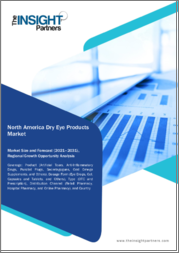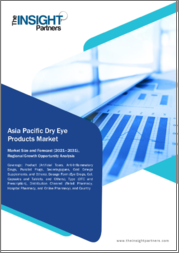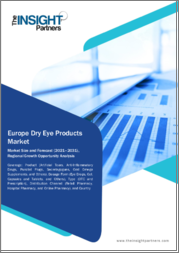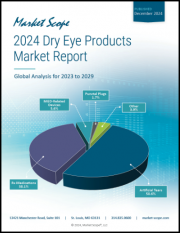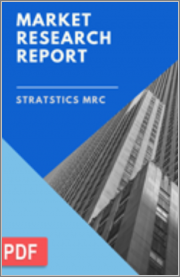
|
시장보고서
상품코드
1383363
안구건조증 치료 시장 예측(-2030년) : 제품 유형, 치료, 투여량, 약물, 진단, 투약 유형, 유통 채널, 최종사용자, 지역별 세계 분석Dry Eye Syndrome Treatment Market Forecasts to 2030 - Global Analysis By Product Type, Treatment, Dose, Drug, Diagnosis, Medication Type, Distribution Channel, End User and By Geography |
||||||
Stratistics MRC에 따르면 안구건조증 치료 세계 시장은 2023년 51억 달러로 예측 기간 동안 9.1%의 CAGR로 성장해 2030년 94억 달러에 달할 것으로 예상됩니다.
안구건조증 또는 색각각결막염(KCS)으로 알려진 안구건조증은 눈 표면의 윤활 또는 수분 부족이 특징입니다. 안구건조증은 누구에게나 발생할 수 있는 광범위한 증상입니다. 다른 안구건조증 증상으로는 시력 저하, 통증이나 작열감, 눈의 통증, 충혈, 눈의 피로감, 눈의 가려움증 및 기타 눈과 관련된 문제 등이 있습니다. 눈물이 나는 것은 눈 표면의 건조가 눈물의 수분 성분 생성을 과도하게 자극하기 때문에 눈물이 나는 것도 안구건조증의 징후입니다.
안과 의료 기업 보쉬롬(Bausch & Lomb)의 투자자 프레젠테이션에 따르면, 미국에는 약 3,800만 명이 안구건조증을 앓고 있으며, 이 중 1,900만 명만이 진단을 받고 있다고 합니다.
증가하는 안구건조증
이 만성 질환은 나이에 따라 사람들에게 다른 영향을 미칩니다. 안구건조증의 유병률은 젊은 층과 노인층 모두에서 증가하고 있으며, 이는 식습관 장애, 콘택트렌즈 사용 증가, 스크린 사용 시간 증가, 라식 수술 증가 등의 결과입니다. 이 질병에 대한 더 강력한 치료 개입의 필요성은 유병률 증가와 함께 증가하여 예측 기간 동안 안구건조증 시장 확대에 박차를 가할 것으로 예상됩니다.
눈 건강에 대한 낮은 우선순위
심각한 임상적 문제가 없는 한 안과 의사와 정기적으로 상담하는 사람은 거의 없습니다. 충혈, 작열감 등의 안구건조증 증상이 진단되지 않은 채로 방치되는 경우가 많습니다. 그 결과, 이러한 처방약으로 치료할 수 있는 환자 수가 줄어들고 있습니다. 따라서 이러한 안구건조증 치료의 수용률이 낮아져 시장 확대 가능성은 제한적입니다.
R&D 활동 증가
안구건조증 치료 시장은 효율적인 치료 라인 구축을 위한 높은 R&D 투자로 인해 확대되고 있습니다. 라식 수술이 증가함에 따라 안구건조증 치료에 대한 수요가 증가하고 있습니다. 첨단 기술 개발에 대한 투자 확대와 신흥국 시장의 증가도 예측 기간 동안 시장 성장을 촉진할 것으로 보입니다.
인식 부족
일반인들은 눈 건강에 대해 잘 알지 못합니다. 안구건조증 증상의 대부분은 정확한 진단과 약물치료로 빠르게 치료하거나 완화할 수 있지만 잘 알려져 있지 않습니다. 임상적으로 큰 문제가 없는 한 환자가 안과 의사를 방문하는 경우는 거의 없습니다. 많은 안구건조증 환자들이 충혈, 염증 및 기타 증상을 무시하거나 오진하기 때문에 처방약으로 치료받을 수 있는 환자 수가 줄어들고 있습니다. 이는 시장 확대에 걸림돌이 되고 있습니다.
COVID-19의 영향:
팬데믹 기간 동안 실시된 수많은 연구에 따르면, 안구건조증은 회복 후에도 몇 주에서 몇 달 동안 지속되는 것으로 나타났습니다. 안구건조증은 흔한 안과 질환이기 때문에 이 질환의 유병률이 증가했습니다. 또한, COVID-19로 인해 사람들의 업무 및 학습 습관이 오프라인에서 온라인으로 점차 전환되면서 안구건조증의 유병률이 높아진 것으로 보입니다. 한편, 팬데믹 기간 동안 불필요한 치료 개입에 대한 상담이 감소하여 이러한 치료에 대한 수요가 감소한 것으로 나타났습니다.
예측 기간 동안 사이클로스포린 부문이 가장 큰 비중을 차지할 것으로 예상
사이클로스포린 부문은 사이클로스포린 기반 약물의 수년간의 사용으로 인해 예측 기간 동안 최대 규모가 될 것으로 예상됩니다. 연구에 따르면 안구건조증의 징후와 증상을 치료하는 데 도움이 되는 것으로 나타났습니다. 시클로스포린은 안구건조증을 유발하는 염증 반응인 T세포 증식을 감소시키는 것으로 보고되고 있으며, Restasis와 Ceqa는 FDA 승인을 받은 안구건조증 치료로서 안구건조증에 대한 치료제로 사용되고 있습니다.
병원 약국 부문은 예측 기간 동안 가장 높은 CAGR을 기록할 것으로 예상
안구건조증 진단 및 치료를 위한 기기 및 약물에 대한 수요가 증가함에 따라 병원 약국 분야는 예측 기간 동안 가장 높은 CAGR을 기록할 것으로 예상됩니다. 안구건조증이 심하거나 복잡한 경우, 전문의의 치료가 필요한 환자들은 병원 약사가 자주 진료합니다. 이러한 환자들은 병원 약국에서 일반적으로 판매되는 면역조절제, 항염증제 등의 처방약을 복용하는 것이 효과적입니다.
최대 점유율을 가진 지역:
예측 기간 동안 북미 지역이 가장 큰 시장 점유율을 차지할 것으로 예상됩니다. 이러한 높은 시장 점유율은 주요 업계 진입자의 존재, 안구건조증 환자 수 증가, 노인 인구 증가 등 다양한 요인에 기인한 것으로 보입니다. 이 지역은 안구건조증 유병률이 상대적으로 높으며, 고령화, 디지털 기기 보급, 환경적 요인 등 다양한 요인이 영향을 미치고 있습니다.
CAGR이 가장 높은 지역:
아시아태평양은 전반적인 의료 인프라 개선, 안구건조증 유병률 증가, 의료 접근성 향상으로 인해 예측 기간 동안 가장 높은 CAGR을 기록할 것으로 예상됩니다. 중국, 인도 등 인구가 많은 국가에서 심혈관 질환의 유병률이 높고, 제품 개발, 제품 승인, 제휴, 협력, 합의 등 시장 진입 기업의 전략과 동향이 증가하면서 이 지역의 확장을 촉진하고 있습니다.
무료 맞춤형 서비스 제공:
이 보고서를 구독하는 고객은 다음과 같은 무료 맞춤형 옵션 중 하나를 사용할 수 있습니다:
- 회사 프로필
- 추가 시장 진입 기업의 종합적인 프로파일링(최대 3개사까지)
- 주요 기업 SWOT 분석(3개사까지)
- 지역 세분화
- 고객의 관심에 따른 주요 국가별 시장 추정 및 예측, CAGR(참고: 타당성 검토에 따른 것임)
- 경쟁사 벤치마킹
- 제품 포트폴리오, 지리적 입지, 전략적 제휴를 기반으로 한 주요 기업 벤치마킹
목차
제1장 주요 요약
제2장 서문
- 개요
- 이해관계자
- 조사 범위
- 조사 방법
- 데이터 마이닝
- 데이터 분석
- 데이터 검증
- 조사 접근법
- 조사 소스
- 1차 조사 소스
- 2차 조사 소스
- 가정
제3장 시장 동향 분석
- 서론
- 성장 촉진요인
- 성장 억제요인
- 기회
- 위협
- 제품 분석
- 최종사용자 분석
- 신흥 시장
- 신종 코로나바이러스 감염증(COVID-19)의 영향
제4장 Porter's Five Forces 분석
- 공급 기업의 교섭력
- 구매자의 교섭력
- 대체품의 위협
- 신규 참여업체의 위협
- 경쟁 기업 간의 경쟁 관계
제5장 세계의 안구건조증 치료 시장 : 제품 유형별
- 서론
- 인공눈물
- 사이클로스포린
- 윤활제
- 코르티코스테로이드
- 눈물점 마개
- 오메가 보충제
- 기타 제품 유형
제6장 세계의 안구건조증 치료 시장 : 치료별
- 서론
- 항염증
- 콜린작용제
- 항감염제
- 윤활제
- 항알레르기제
- 기타 치료법
제7장 세계의 안구건조증 치료 시장 : 투여량별
- 서론
- 다회 투여
- 일회 투여
제8장 세계의 안구건조증 치료 시장 : 약제별
- 서론
- Xiidra
- Restasis
- Cequa
- Eysuvis
- Tyrvaya
- 기타 약제
제9장 세계의 안구건조증 치료 시장 : 진단별
- 서론
- 눈물 삼투압 시험
- 쉬르머 시험
- 종합 시력 검사
제10장 세계의 안구건조증 치료 시장 : 투약 유형별
- 서론
- 시판약(OTC)
- 처방전(Rx) 약
- 기타
제11장 세계의 안구건조증 치료 시장 : 유통 채널별
- 서론
- 병원 약국
- 소매 약국
- 온라인 약국
제12장 세계의 안구건조증 치료 시장 : 최종사용자별
- 서론
- 재택의료
- 병원
- 전문 클리닉
- 기타 최종사용자
제13장 세계의 안구건조증 치료 시장 : 지역별
- 서론
- 북미
- 미국
- 캐나다
- 멕시코
- 유럽
- 독일
- 영국
- 이탈리아
- 프랑스
- 스페인
- 기타 유럽
- 아시아태평양
- 일본
- 중국
- 인도
- 호주
- 뉴질랜드
- 한국
- 기타 아시아태평양
- 남미
- 아르헨티나
- 브라질
- 칠레
- 기타 남미
- 중동 및 아프리카
- 사우디아라비아
- 아랍에미리트
- 카타르
- 남아프리카공화국
- 기타 중동 및 아프리카
제14장 주요 발전
- 계약, 파트너십, 협업, 합작투자
- 인수와 합병
- 신제품 발매
- 사업 확대
- 기타 주요 전략
제15장 기업 개요
- Novartis AG
- Eli Lilly and Company
- AbbVie, Inc.
- Teva Pharmaceutical Industries Ltd.
- Sun Pharmaceutical Industries Ltd.
- Sanofi
- Santen Pharmaceutical Co., Ltd.
- Pfizer Inc.
- AFT Pharmaceuticals
- Merck & Co., Inc.
- Johnson & Johnson Services, Inc.
- Akorn Operating Company LLC
- Bausch+Lomb Corporation
- Allergan
- OASIS Medical
- GlaxoSmithKline plc
- Oyster Point Pharma, Inc.
- Otsuka America Pharmaceutical, Inc.
- Novaliq GmbH
- F. Hoffmann-La Roche Ltd.
According to Stratistics MRC, the Global Dry Eye Syndrome Market is accounted for $5.1 billion in 2023 and is expected to reach $9.4 billion by 2030 growing at a CAGR of 9.1% during the forecast period. The disease known as dry eye syndrome, or keratoconjunctivitis sicca (KCS), is characterized by a lack of lubrication or moisture on the eye's surface. It is a widespread condition that can affect anyone at any time. Other dry eye symptoms include photophobia, aching and burning feelings, hurting eyes, red eyes, fatigued eyes, itchy eyes, and other eye-related issues. Watery eyes can also be a sign because the dryness of the eye's surface over-stimulates the creation of the watery component of tears.
According to investor presentation of Bausch + Lomb, a leading eye care company, in U.S. an estimated 38 million people affected with dry eye disease (DED) out of which only 19 million were diagnosed.
Market Dynamics:
Driver:
Growing prevalence of dry eye syndrome
This chronic illness affects people differently as they age. The prevalence is rising in both the young and the elderly population, though, as a result of bad food, increased use of contact lenses, more screen time, and an increase in LASIK procedures. The need for more potent treatment interventions for this illness will rise as its prevalence rises, fueling the expansion of the dry eye syndrome market throughout the projected period.
Restraint:
Low priority given to eye health
Unless there is a severe clinical problem, people seldom consult ophthalmologists on a regular basis. It happens frequently that dry eye symptoms like redness, burning, and other similar ones go undiagnosed. The number of patients who can be treated with these prescription medications as a result of this has decreased. The market expansion potential is therefore limited as a result of the lower acceptance rate of these eye care products.
Opportunity:
Increase in the number of R & D activities
The market for treating dry eye problems is expanding as a consequence of the high R&D investment on the creation of efficient treatment lines. As the country performs more LASIK surgeries, there is a growing demand for treatments for dry eye syndrome. Rising investments in the development of advanced technologies and an increase in the number of emerging markets will also help the market grow during the forecast period.
Threat:
Lack of awareness
The general public knows virtually little about eye health. Many of the symptoms of dry eyes, which may be swiftly cured or relieved with a correct diagnosis and medications, are not well known. Patients rarely visit ophthalmologists unless there is a major clinical problem. Many dry eye sufferers have their redness, irritation, and other symptoms ignored or misdiagnosed, which reduces the number of individuals who may receive prescription pharmaceutical treatment. This is limiting the market from expanding.
COVID-19 Impact:
Numerous investigations conducted during the pandemic discovered that individuals continued to experience dry eye symptoms for several weeks or months after they had recovered. As this is a prevalent ophthalmic disorder, this resulted in a rise in the prevalence of this ailment. Additionally, during the COVID-19, a gradual transition in people's work and study habits from offline to online led to a rise in the prevalence of this disorder. On the other hand, it was discovered that throughout the pandemic, consultations for all non-essential therapeutic interventions had decreased, which led to a fall in the demand for these therapies.
The cyclosporine segment is expected to be the largest during the forecast period
The cyclosporine segment is expected to be the largest during the forecast period owing to the long-standing use of medications using cyclosporine as a basis. Research has shown its usefulness for treating the signs and symptoms of dry eye illness. Cyclosporine has been reported to decrease T-cell proliferation, an inflammatory response that contributes to disease. Restasis and Cequa are two drugs for treating the symptoms of dry eye that have FDA approval.
The hospital pharmacy segment is expected to have the highest CAGR during the forecast period
The hospital pharmacy segment is expected to have the highest CAGR during the forecast period owing to increasing demand for devices and drugs for the diagnosis and treatment of dry eye disease. Patients with more severe or complicated instances of dry eye disease who needs specialist care are frequently catered to by hospital pharmacists. These patients may benefit from taking prescription drugs like Immunomodulators or anti-inflammatory drugs, which are commonly sold at hospital pharmacies.
Region with largest share:
North America is projected to hold the largest market share during the forecast period. This high market share may be ascribed to a variety of factors, including the presence of significant industry players, an increase in the number of patients suffering from dry eye disease, an expanding elderly population, among others. This region has a relatively high prevalence of dry eye disease, driven by various factors such as an aging population, widespread use of digital devices, and environmental factors.
Region with highest CAGR:
Asia Pacific is projected to hold the highest CAGR over the forecast period due to improvements in overall healthcare infrastructure, rising prevalence of dry eye disease, and improved access to healthcare. The high prevalence of cardiovascular diseases in countries with high populations, such as China and India, as well as the rising number of market players' strategies and trends, such as product development, product approval, partnership, collaboration, and agreement, are driving the region to expand.
Key players in the market
Some of the key players in Dry Eye Syndrome market include: Novartis AG, Eli Lilly and Company, AbbVie, Inc., Teva Pharmaceutical Industries Ltd., Sun Pharmaceutical Industries Ltd., Sanofi, Santen Pharmaceutical Co., Ltd., Pfizer Inc ., AFT Pharmaceuticals, Merck & Co., Inc. , Johnson & Johnson Services, Inc., Akorn Operating Company LLC , Bausch + Lomb Corporation, Allergan, OASIS Medical, GlaxoSmithKline plc, Oyster Point Pharma, Inc., Otsuka America Pharmaceutical, Inc., Novaliq GmbH and F. Hoffmann-La Roche Ltd.
Key Developments:
In June 2023, Novaliq GmbH announced that the U.S. Food and Drug Administration (FDA) has approved VEVYE (cyclosporine ophthalmic solution) 0.1% for the treatment of the signs and symptoms of dry eye disease.
In May 2023, Bausch + Lomb Corporation and Novaliq GmbH announced that the U.S. Food and Drug Administration (FDA) has approved MIEBO (perfluorohexyloctane ophthalmic solution; formerly known as NOV03), for the treatment of the signs and symptoms of dry eye disease (DED). MIEBO is the first and only FDA-approved treatment for DED that directly targets tear evaporation.
Product Types Covered:
- Artificial Tears
- Cyclosporine
- Lubricants
- Corticosteroids
- Punctual Bags
- Omega Supplements
- Other Product Types
Treatments Covered:
- Anti-Inflammatory
- Cholinergics
- Anti-Infectives
- Lubricating Agent
- Anti-Allergics
- Other Treatments
Doses Covered:
- Multi Dose
- Unit Dose
Drugs Covered:
- Xiidra
- Restasis
- Cequa
- Eysuvis
- Tyrvaya
- Other Drugs
Diagnosis Covered:
- Tear Osmolarity Test
- Schirmer Test
- Comprehensive Eye Exam
Medication Types Covered:
- Over the counter (OTC) Drug
- Prescription (Rx) Drug
- Other Medication Types
Distribution Channels Covered:
- Hospital Pharmacy
- Retail Pharmacy
- Online Pharmacy
End Users Covered:
- Homecare
- Hospitals
- Specialty Clinics
- Other End Users
Regions Covered:
- North America
- US
- Canada
- Mexico
- Europe
- Germany
- UK
- Italy
- France
- Spain
- Rest of Europe
- Asia Pacific
- Japan
- China
- India
- Australia
- New Zealand
- South Korea
- Rest of Asia Pacific
- South America
- Argentina
- Brazil
- Chile
- Rest of South America
- Middle East & Africa
- Saudi Arabia
- UAE
- Qatar
- South Africa
- Rest of Middle East & Africa
What our report offers:
- Market share assessments for the regional and country-level segments
- Strategic recommendations for the new entrants
- Covers Market data for the years 2021, 2022, 2023, 2026, and 2030
- Market Trends (Drivers, Constraints, Opportunities, Threats, Challenges, Investment Opportunities, and recommendations)
- Strategic recommendations in key business segments based on the market estimations
- Competitive landscaping mapping the key common trends
- Company profiling with detailed strategies, financials, and recent developments
- Supply chain trends mapping the latest technological advancements
Free Customization Offerings:
All the customers of this report will be entitled to receive one of the following free customization options:
- Company Profiling
- Comprehensive profiling of additional market players (up to 3)
- SWOT Analysis of key players (up to 3)
- Regional Segmentation
- Market estimations, Forecasts and CAGR of any prominent country as per the client's interest (Note: Depends on feasibility check)
- Competitive Benchmarking
- Benchmarking of key players based on product portfolio, geographical presence, and strategic alliances
Table of Contents
1 Executive Summary
2 Preface
- 2.1 Abstract
- 2.2 Stake Holders
- 2.3 Research Scope
- 2.4 Research Methodology
- 2.4.1 Data Mining
- 2.4.2 Data Analysis
- 2.4.3 Data Validation
- 2.4.4 Research Approach
- 2.5 Research Sources
- 2.5.1 Primary Research Sources
- 2.5.2 Secondary Research Sources
- 2.5.3 Assumptions
3 Market Trend Analysis
- 3.1 Introduction
- 3.2 Drivers
- 3.3 Restraints
- 3.4 Opportunities
- 3.5 Threats
- 3.6 Product Analysis
- 3.7 End User Analysis
- 3.8 Emerging Markets
- 3.9 Impact of Covid-19
4 Porters Five Force Analysis
- 4.1 Bargaining power of suppliers
- 4.2 Bargaining power of buyers
- 4.3 Threat of substitutes
- 4.4 Threat of new entrants
- 4.5 Competitive rivalry
5 Global Dry Eye Syndrome Treatment Market, By Product Type
- 5.1 Introduction
- 5.2 Artificial Tears
- 5.3 Cyclosporine
- 5.4 Lubricants
- 5.5 Corticosteroids
- 5.6 Punctual Bags
- 5.7 Omega Supplements
- 5.8 Other Product Types
6 Global Dry Eye Syndrome Treatment Market, By Treatment
- 6.1 Introduction
- 6.2 Anti-Inflammatory
- 6.3 Cholinergics
- 6.4 Anti-Infectives
- 6.5 Lubricating Agent
- 6.6 Anti-Allergics
- 6.7 Other Treatments
7 Global Dry Eye Syndrome Treatment Market, By Dose
- 7.1 Introduction
- 7.2 Multi Dose
- 7.3 Unit Dose
8 Global Dry Eye Syndrome Treatment Market, By Drug
- 8.1 Introduction
- 8.2 Xiidra
- 8.3 Restasis
- 8.4 Cequa
- 8.5 Eysuvis
- 8.6 Tyrvaya
- 8.7 Other Drugs
9 Global Dry Eye Syndrome Treatment Market, By Diagnosis
- 9.1 Introduction
- 9.2 Tear Osmolarity Test
- 9.3 Schirmer Test
- 9.4 Comprehensive Eye Exam
10 Global Dry Eye Syndrome Treatment Market, By Medication Type
- 10.1 Introduction
- 10.2 Over the counter (OTC) Drug
- 10.3 Prescription (Rx) Drug
- 10.4 Other Medication Types
11 Global Dry Eye Syndrome Treatment Market, By Distribution Channel
- 11.1 Introduction
- 11.2 Hospital Pharmacy
- 11.3 Retail Pharmacy
- 11.4 Online Pharmacy
12 Global Dry Eye Syndrome Treatment Market, By End User
- 12.1 Introduction
- 12.2 Homecare
- 12.3 Hospitals
- 12.4 Specialty Clinics
- 12.5 Other End Users
13 Global Dry Eye Syndrome Treatment Market, By Geography
- 13.1 Introduction
- 13.2 North America
- 13.2.1 US
- 13.2.2 Canada
- 13.2.3 Mexico
- 13.3 Europe
- 13.3.1 Germany
- 13.3.2 UK
- 13.3.3 Italy
- 13.3.4 France
- 13.3.5 Spain
- 13.3.6 Rest of Europe
- 13.4 Asia Pacific
- 13.4.1 Japan
- 13.4.2 China
- 13.4.3 India
- 13.4.4 Australia
- 13.4.5 New Zealand
- 13.4.6 South Korea
- 13.4.7 Rest of Asia Pacific
- 13.5 South America
- 13.5.1 Argentina
- 13.5.2 Brazil
- 13.5.3 Chile
- 13.5.4 Rest of South America
- 13.6 Middle East & Africa
- 13.6.1 Saudi Arabia
- 13.6.2 UAE
- 13.6.3 Qatar
- 13.6.4 South Africa
- 13.6.5 Rest of Middle East & Africa
14 Key Developments
- 14.1 Agreements, Partnerships, Collaborations and Joint Ventures
- 14.2 Acquisitions & Mergers
- 14.3 New Product Launch
- 14.4 Expansions
- 14.5 Other Key Strategies
15 Company Profiling
- 15.1 Novartis AG
- 15.2 Eli Lilly and Company
- 15.3 AbbVie, Inc.
- 15.4 Teva Pharmaceutical Industries Ltd.
- 15.5 Sun Pharmaceutical Industries Ltd.
- 15.6 Sanofi
- 15.7 Santen Pharmaceutical Co., Ltd.
- 15.8 Pfizer Inc.
- 15.9 AFT Pharmaceuticals
- 15.10 Merck & Co., Inc.
- 15.11 Johnson & Johnson Services, Inc.
- 15.12 Akorn Operating Company LLC
- 15.13 Bausch + Lomb Corporation
- 15.14 Allergan
- 15.15 OASIS Medical
- 15.16 GlaxoSmithKline plc
- 15.17 Oyster Point Pharma, Inc.
- 15.18 Otsuka America Pharmaceutical, Inc.
- 15.19 Novaliq GmbH
- 15.20 F. Hoffmann-La Roche Ltd.










